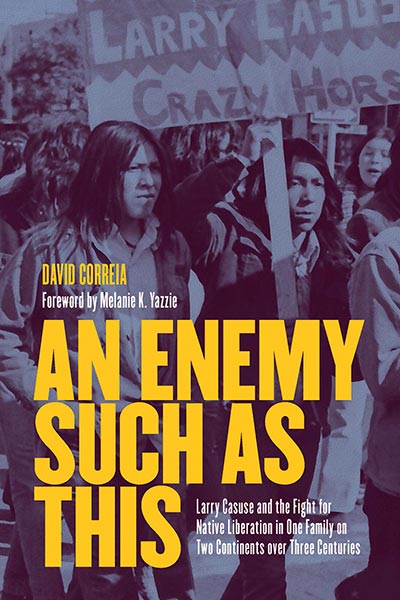
Guest Column | Portrait of Larry Casuse examines history of family saga
By Jennifer Denetdale
David Correia, An Enemy Such as This: Larry Casuse and the Fight for Native Liberation in One Family on Two Continents over Three Centuries. Foreword by Melanie K. Yazzie (Chicago, Haymarket Books, 2022)
On March 1, 1973, in Albuquerque, University of New Mexico Kiva President Larry Casuse and his comrade Robert Nakaidinae took Delbert Rudy hostage on the University of New Mexico campus and drove his car to Gallup where Rudy was released.

Book cover: David Correia, An Enemy Such as This: Larry Casuse and the Fight for Native Liberation in One Family on Two Continents over Three Centuries. Foreword by Melanie K. Yazzie (Chicago, Haymarket Books, 2022)
Larry and Robert then took Gallup Mayor Emmett Garcia hostage.
These events compose the first chapter of David Correia’s history of Casuse’s family saga.
Correia’s final chapter returns to this extraordinary first day of March when Casuse is killed by police fire.
Between these two chapters, Correia creates a nuanced portrait of 19-year-old Larry, as a Diné man enraged by a tradition of Indian-hating and a believer in Indigenous liberation.
For Casuse, the violence against Indians would never be ordinary, something to be ignored.
Correia traces a global history of settler colonialism and its intersection with the never-ending wars against Indigenous peoples to search for answers to Larry’s sacrifice of his life on that fateful day.
Rather than concluding with a definitive answer, he writes, “Whatever Larry’s reasons may have been, they died with him on that sidewalk in Gallup, New Mexico on March 1, 1973.”
Larry’s story takes shape through histories of global violence that bring his parents, Louis Casuse and Lillian Hutzler, together when Louis joined the U.S. army and is detailed to war-torn Salzburg, Austria in the aftermath of Nazi Germany’s fall.
After the war, life in the U.S. was not easy for the young Casuse couple. Louis returned to his work as a miner at the Santa Rita mine in southern New Mexico and Lillian, refusing to stay in Mexican Springs, followed her husband.
It is in Santa Rita that Larry Wayne Casuse arrived into the world. As the oldest, Larry was loving and caring toward his siblings, qualities they remember about him long past their brother’s death.
The history of the Santa Rita mine crosses the international boundaries of Mexico and the U.S. where the earliest conquerors, whether they be Mexicans or Americans, bloodied the ground with Indigenous lives.
Navajo men were recruited to work at the mine, but the conditions were so horrendous that Louis is only one of two Diné who withstand the backbreaking labor required.
As an “Indian,” Louis was relegated to hard labor and lived in “Indian Village,” while white workers enjoyed housing with amenities. As Corriea puts it, “What a thing to work for a wage, to labor in the production of great wealth, and to grow poorer because of it.”
This crucible of inequity was the backdrop for Larry Casuse’s political awakening.
Years of impoverishment took a toll on the family; Louis and Lillian divorced and Lillian moved the family to Gallup.
Larry’s challenge to Gallup and especially to Mayor Garcia – who owned one of the most predatory “Indian bars” in McKinley County – takes an even more serious turn when Garcia was nominated as regent for the University of New Mexico.
All of Larry’s efforts to decry Garcia as the worst choice for a regent seem to inevitably fold into his decision to send a message to Indian haters by taking Garcia hostage.
Correia’s history ends with that fateful day, March 1, 1973, when Larry and Robert left the mayor’s office with Emmett Garcia in tow, handcuffed as they walked towards downtown.
Surrounded by police and gaping on-lookers, the trio entered Stearns Sporting Goods.
Their plan was to send a vital message to Gallup: Native people should be taken seriously and that profiteering on Navajo and Native misery must cease.
That afternoon, police fired into the store, killing Larry.
Later, the local newspaper published a photograph of police standing over Larry’s dead body, draped in a blanket, like trophy hunters and their prize kill.
Outraged, Diné and Native communities marched to honor Larry Casuse’s life and to protest the conditions of life for Diné that led to his sacrifice.
Robert was arrested and during his time in jail he penned a song for Larry, “Song from a Gallup Jail.” Correia ends his history with the music score.
Larry’s refusal to take Diné deaths as ordinary, the sacrifice of his life, is remembered. Larry was not afraid to claim liberation for his people. As Melanie K. Yazzie, co-founder of The Red Nation, writes in her foreword, “We aren’t `afraid to be Indigenous in our homelands.’”
It’s been a long time since a history has touched me so deeply with its poignancy. David Correia offers a masterful original narrative that draws upon meticulous archival research and conversations and support from the Casuse family.
Book talks with David Correia and the Casuse family are scheduled on April 25 at the UNM campus, Student Union Building, Lobo A & B, and on April 30 at the Gallup downtown conference center at 6:30 p.m.
Multidisciplinary artist JJ Otero will perform the song for Larry at both events.
Information: Jennifer Denetdale, jdenet@unm.edu
David Corriea is professor of American Studies at the University of New Mexico. Jennifer Denetdale, from Tohatchi, is a professor and chair of American Studies at the University of New Mexico.







 Highway 264,
Highway 264, I-40, WB @ Winslow
I-40, WB @ Winslow